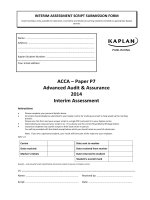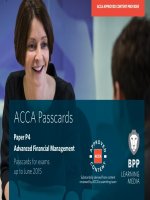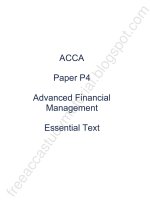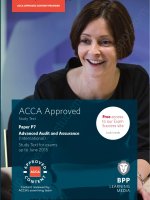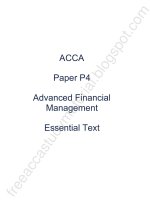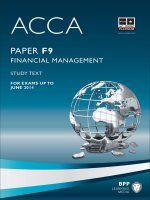ACCA p7 complete text 2016
Bạn đang xem bản rút gọn của tài liệu. Xem và tải ngay bản đầy đủ của tài liệu tại đây (14.1 MB, 690 trang )
ACCA
Paper P7 (INT/UK)
Advanced Audit and
Assurance
Complete Text
British library cataloguinginpublication data
A catalogue record for this book is available from the British Library.
Published by:
Kaplan Publishing UK
Unit 2 The Business Centre
Molly Millars Lane
Wokingham
Berkshire
RG41 2QZ
ISBN 9781784152246
© Kaplan Financial Limited, 2015
The text in this material and any others made available by any Kaplan Group company does not
amount to advice on a particular matter and should not be taken as such. No reliance should be
placed on the content as the basis for any investment or other decision or in connection with any
advice given to third parties. Please consult your appropriate professional adviser as necessary.
Kaplan Publishing Limited and all other Kaplan group companies expressly disclaim all liability to any
person in respect of any losses or other claims, whether direct, indirect, incidental, consequential or
otherwise arising in relation to the use of such materials.
Printed and bound in Great Britain.
Acknowledgements
We are grateful to the Association of Chartered Certified Accountants and the Chartered Institute of
Management Accountants for permission to reproduce past examination questions. The answers
have been prepared by Kaplan Publishing.
All rights reserved. No part of this publication may be reproduced, stored in a retrieval system, or
transmitted, in any form or by any means, electronic, mechanical, photocopying, recording or
otherwise, without the prior written permission of Kaplan Publishing.
ii
KAPLAN PUBLISHING
Contents
Page
Chapter 1
Regulation in a global economy
Chapter 2
Code of ethics and conduct
29
Chapter 3
Professional appointments
73
Chapter 4
Quality control
83
Chapter 5
Advertising, publicity, obtaining professional
work and fees
111
Chapter 6
Tendering
127
Chapter 7
Money laundering
137
Chapter 8
Professional responsibilities and liabilities
149
Chapter 9
Planning, materiality and assessing the risk of
misstatement
193
Chapter 10
Group and transnational audits
247
Chapter 11
Evidence
285
Chapter 12
Completion
325
Chapter 13
Auditors’ reports
371
Chapter 14
Reports to those charged with governance
415
Chapter 15
Other assignments
427
Chapter 16
Prospective financial information
455
Chapter 17
Audit of social, environmental and integrated
reporting
473
Chapter 18
Forensic audits
497
Chapter 19
Outsourcing and internal audit
511
Chapter 20
UK syllabus only: Auditing aspects of insolvency 527
Chapter 21
INT syllabus only: Audit of performance
information in the public sector
KAPLAN PUBLISHING
1
545
iii
iv
Chapter 22
Financial reporting revision
555
Chapter 23
Additional practice questions
607
KAPLAN PUBLISHING
chapter
Introduction
Paper Introduction
v
Introduction
How to Use the Materials
These Kaplan Publishing learning materials have been carefully designed to
make your learning experience as easy as possible and to give you the best
chances of success in your examinations.
The product range contains a number of features to help you in the study
process. They include:
(1) Detailed study guide and syllabus objectives
(2) Description of the examination
(3) Study skills and revision guidance
(4) Complete text or essential text
(5) Question practice
The sections on the study guide, the syllabus objectives, the examination
and study skills should all be read before you commence your studies. They
are designed to familiarise you with the nature and content of the
examination and give you tips on how to best to approach your learning.
The complete text or essential text comprises the main learning
materials and gives guidance as to the importance of topics and where
other related resources can be found. Each chapter includes:
vi
•
The learning objectives contained in each chapter, which have been
carefully mapped to the examining body's own syllabus learning
objectives or outcomes. You should use these to check you have a clear
understanding of all the topics on which you might be assessed in the
examination.
•
The chapter diagram provides a visual reference for the content in the
chapter, giving an overview of the topics and how they link together.
•
The content for each topic area commences with a brief explanation or
definition to put the topic into context before covering the topic in detail.
You should follow your studying of the content with a review of the
illustration/s. These are worked examples which will help you to
understand better how to apply the content for the topic.
•
Test your understanding sections provide an opportunity to assess
your understanding of the key topics by applying what you have learned
to short questions. Answers can be found at the back of each chapter.
KAPLAN PUBLISHING
•
Summary diagrams complete each chapter to show the important
links between topics and the overall content of the paper. These
diagrams should be used to check that you have covered and
understood the core topics before moving on.
•
Question practice is provided at the back of each text.
Quality and accuracy are of the utmost importance to us so if you spot an
error in any of our products, please send an email to
with full details, or follow the link to the
feedback form in MyKaplan.
Our Quality Coordinator will work with our technical team to verify the error
and take action to ensure it is corrected in future editions.
Icon Explanations
Definition – Key definitions that you will need to learn from the core content.
Key Point – Identifies topics that are key to success and are often
examined.
New – Identifies topics that are brand new in papers that build on, and
therefore also contain, learning covered in earlier papers.
Expandable Text – Expandable text provides you with additional
information about a topic area and may help you gain a better
understanding of the core content.
Test Your Understanding – Exercises for you to complete to ensure that
you have understood the topics just learned.
Illustration – Worked examples help you understand the core content
better.
Tricky topic – When reviewing these areas care should be taken and all
illustrations and test your understanding exercises should be completed to
ensure that the topic is understood.
Tutorial note – Included to explain some of the technical points in more
detail.
Footsteps – Helpful tutor tips.
KAPLAN PUBLISHING
vii
Introduction
Online subscribers
Our online resources are designed to increase the flexibility of your learning
materials and provide you with immediate feedback on how your studies
are progressing. Ask your local customer services staff if you are not
already a subscriber and wish to join.
If you are subscribed to our online resources you will find:
(1) Online reference ware: reproduces your Complete Text online, giving
you anytime, anywhere access.
(2) Online testing: provides you with additional online objective testing so
you can practice what you have learned further.
(3) Online performance management: immediate access to your online
testing results. Review your performance by key topics and chart your
achievement through the course relative to your peer group.
Paper introduction
Paper background
The aim of ACCA Paper P7 (INT & UK), Advanced audit and assurance, is
to analyse, evaluate and conclude on the assurance engagement and other
audit and assurance issues in the context of best practice and current
developments.
Objectives of the syllabus
viii
•
Recognise the legal and regulatory environment and its impact on audit
and assurance practice.
•
Demonstrate the ability to work effectively on an assurance or other
service engagement within a professional and ethical framework.
•
Assess and recommend appropriate quality control policies and
procedures in practice management and recognise the auditor's
position in relation to the acceptance and retention of professional
appointments.
•
Identify and formulate the work required to meet the objectives of audit
assignments and apply the International Standards on Auditing.
•
Identify and formulate the work required to meet the objectives of non
audit assignments.
•
Evaluate findings and the results of work performed and draft suitable
reports on assignments.
•
Understand the current issues and developments relating to the
provision of auditrelated and assurance services.
KAPLAN PUBLISHING
Core areas of the syllabus
•
•
•
•
•
•
•
Regulatory environment
Professional and ethical considerations
Practice management
Audit of historical financial information
Other assignments
Reporting
Current issues and developments.
Approach to INT and UK syllabus elements
Due to the alignment of the INT and UK syllabus elements one text has been
produced to address both variants. Both streams apply the principles of
International Standards on Auditing (ISA's) and International Financial
Reporting Standards (IFRS).
The International variant has been used as the basis of the text. Any
variances relevant only to the UK syllabus (such as compliance with the
Companies Act 2006) have been included at the end of each chapter (or
section) in expandable text boxes headed "UK Syllabus Focus." All test your
understandings have also been appended to reflect any UK specific
variations.
Syllabus objectives
We have reproduced the ACCA’s syllabus below, showing where the
objectives are explored within this book. Within the chapters, we have
broken down the extensive information found in the syllabus into easily
digestible and relevant sections, called Content Objectives. These
correspond to the objectives at the beginning of each chapter.
Syllabus learning objective
A REGULATORY ENVIRONMENT
1 International regulatory frameworks for audit and
assurance services
(a) Explain the need for laws, regulations, standards and
other guidance relating to audit, assurance and
related services.[2]
KAPLAN PUBLISHING
Chapter
reference
1
ix
Introduction
(b) Outline and explain the need for the legal and
professional framework including: [2]
1
(i) public oversight to an audit and assurance practice
(ii) the role of audit committees and impact on audit and
assurance practice (UK: discuss the provision of the
UK Corporate Governance Code and its impact on
audit and assurance practice).
2 Money laundering
(a) Define ‘money laundering’.[1]
7
(b) Explain how international efforts seek to combat
money laundering.[2]
7
(c) Explain the scope of criminal offences of money
laundering and how professional accountants may be
protected from criminal and civil liability.[2]
7
(d) Explain the need for ethical guidance in this area.[2]
7
(e) Describe how accountants meet their obligations to
help prevent and detect money laundering including
record keeping and reporting of suspicion to the
appropriate regulatory body.[2]
7
(f)
7
Explain the importance of customer due diligence
(CDD) (UK: 'know you customer' information (KYC)).
[2]
3
x
(g) Recognise potentially suspicious transactions and
assess their impact on reporting duties.[2]
7
(h) Describe, with reasons, the basic elements of an
antimoney laundering program.[2]
Laws and regulations
7
(a) Compare and contrast the respective responsibilities
of management and auditors concerning compliance
with laws and regulations in an audit of financial
statements.[2]
8
(b) Describe the auditors’ considerations of compliance
with laws and regulations and plan audit procedures
when possible noncompliance is discovered.[2]
8
(c) Discuss how and to whom noncompliance should be
reported.[2]
8
(d) Recognise when withdrawal from an engagement is
necessary.[2]
8
KAPLAN PUBLISHING
B PROFESSIONAL AND ETHICAL CONSIDERATIONS
1 Code of ethics for professional accountants (UK:
Code of ethics and conduct)
(a) Explain the fundamental principles and the
2
conceptual framework approach.[1]
(b) Identify, evaluate and respond to threats to
compliance with the fundamental principles.[3]
2
(c) Discuss and evaluate the effectiveness of available
safeguards.[3]
2
(d) Recognise and advise on conflicts in the application
of fundamental principles.[3]
2
(e) Discuss the importance of professional scepticism in
planning and performing an audit.[2]
9
(f)
9
(a) Define and clearly distinguish between the terms
‘error’, ‘irregularity’, ‘fraud’ and ‘misstatement’.[2]
8
(b) Compare and contrast the respective responsibilities
of management and auditors for fraud and error.[2]
8
(c) Describe the matters to be considered and
procedures to be carried out to investigate actual
and/or potential misstatements in a given situation.[2]
8
(d) Explain how, why, when and to whom fraud and error
should be reported and the circumstances in which
an auditor should withdraw from an engagement.[2]
8
(e) Discuss the current and possible future role of
auditors in preventing, detecting and reporting error
and fraud.[2]
Professional liability
8
(a) Recognise circumstances in which professional
accountants may have legal liability.[2]
8
(b) Describe the factors to determine whether or not an
auditor is negligent in given situations.[2]
8
(c) Explain the other criteria for legal liability to be
recognised (including ‘due professional care’ and
‘proximity’) and apply them to given situations.[2]
8
(d) Compare and contrast liability to client with liability
to third parties.[3]
8
Assess whether an engagement has been planned
and performed with an attitude of professional
scepticism, and evaluate the implications.[3]
2 Fraud and error
3
KAPLAN PUBLISHING
xi
Introduction
(e) Evaluate the practicability and effectiveness of ways
in which liability may be restricted.[3]
(f)
Discuss liability limitation agreements.[2]
xii
8
(g) Discuss and appraise the principal causes of audit
failure and other factors that contribute to the
‘expectation gap’ (e.g. responsibilities for fraud and
error).[3]
8
(h) Recommend ways in which the expectation gap
might be bridged.[2]
8
C PRACTICE MANAGEMENT
1 Quality control
(a) Explain the principles and purpose of quality control
of audit and other assurance engagements.[1]
2
8
4
(b) Describe the elements of a system of quality control
relevant to a given firm.[2]
4
(c) Select and justify quality control procedures that are
applicable to a given audit engagement.[3]
4
(d) Assess whether an engagement has been planned
and performed in accordance with professional
standards and whether reports issued are
appropriate in the circumstances.[3]
Advertising, publicity, obtaining professional work
and fees
4
(a) Recognise situations in which specified
advertisements are acceptable.[2]
5
(b) Discuss the restrictions on practice descriptions, the
use of the ACCA logo and the names of practising
firms.[2]
5
(c) Discuss the extent to which reference to fees may be
made in promotional material.[2]
5
(d) Outline the determinants of feesetting and justify the
bases on which fees and commissions may and may
not be charged for services.[3]
5
(e) Discuss the ethical and other professional problems,
for example, lowballing, involved in establishing and
negotiating fees for a specified assignment.[3]
5
KAPLAN PUBLISHING
3
Tendering
(a) Discuss the reasons why entities change their
auditors/professional accountants.[2]
6
(b) Recognise and explain the matters to be considered
when a firm is invited to submit a proposal or fee
quote for an audit or other professional engagement.
6
[2]
4
(c) Identify the information to be included in a proposal.[2]
Professional appointments
6
(a) Explain the matters to be considered and the
procedures that an audit firm/professional accountant
should carry out before accepting a specified new
client/engagement including: [3]
3
(i) client acceptance
(ii) engagement acceptance
(iii) establish whether the preconditions for an audit are
present
(iv) agreeing the terms of engagement.
(b) Recognise the key issues that underlie the
agreement of the scope and terms of an engagement
with a client.[2]
D AUDIT OF HISTORICAL FINANCIAL INFORMATION
1 Planning, materiality and assessing the risk of
misstatement
(a) Define materiality and performance materiality and
demonstrate how it should be applied in financial
reporting and auditing.[2]
9
(b) Identify and explain business risks for a given
assignment.[3]
9
(c) Identify and explain audit risks for a given
assignment.[3]
9
(d) Identify and explain risks of material misstatement for
a given assignment.[3]
9
(e) Discuss and demonstrate the use of analytical
procedures in the planning of an assignment.[3]
9
KAPLAN PUBLISHING
xiii
Introduction
(f)
Explain how the result of planning procedures
determines the relevant audit strategy.[2]
9
(g) Explain the planning procedures specific to an initial
audit engagement.[2]
9
(h) Identify additional information that may be required in
order to effectively plan an assignment.[2]
9
(i) Recognise matters that are not relevant to the
planning of an assignment.[2]
2 Evidence
9
(a) Identify and describe audit procedures to obtain
sufficient audit evidence from identified sources (UK:
including an assessment of the use of IT to assist the
auditor and the use of Computerassisted audit
techniques (CAATs) where appropriate).[2]
11
(b) Identify and evaluate the audit evidence expected to
be available to: [3]
11
(i) support financial statement assertions and
accounting treatments (including fair values)
(ii) support disclosures made in the notes to the financial
statements.
xiv
(c) Apply analytical procedures to financial and non
financial data.[2]
11
(d) Explain the specific audit problems and procedures
concerning related parties and related party
transactions.[2]
11
(e) Recognise circumstances that may indicate the
existence of unidentified related parties and select
appropriate audit procedures.[2]
11
(f)
11
Evaluate the use of written management
representations to support other audit evidence.[2]
(g) Recognise when it is justifiable to place reliance on
the work of an expert (e.g. a surveyor employed by
the audit client).[2]
11
(h) Assess the appropriateness and sufficiency of the
work of internal auditors and the extent to which
reliance can be placed on it.[2]
11
KAPLAN PUBLISHING
3 Evaluation and review
(a) Evaluate the matters (e.g. materiality, risk, relevant
accounting standards, audit evidence) relating to:[3]
(i)
inventory
(ii)
standard costing systems
12
(iii) statement of cash flows
(iv) changes in accounting policy
(v)
taxation (including deferred tax)
(vi) segmental reporting
(vii) noncurrent assets
(viii) fair value
(ix) leases
(x)
revenue from contracts with customers
(xi) employee benefits
(xii) government grants
(xiii) related parties
(xiv) earnings per share
(xv) impairment
(xvi) provisions, contingent liabilities and contingent
assets
(xvii) intangible assets
(xviii)financial instruments
(xix) investment properties
(xx) sharebased payment transactions
(xxi) business combinations
(xxii) assets held for sale and discontinued operations
(xxiii)events after the end of the reporting period
(xxiv)the effects of foreign exchange rates
(xxv) borrowing costs
(b) Explain the use of analytical procedures and checklists in
evaluation and review.[3]
12
(c) Explain how the auditor’s responsibilities for corresponding
12
figures, comparative financial statements, and ‘other information’
are discharged.[3]
(d) Apply the further considerations and audit procedures relevant to 12
initial engagements.[2]
KAPLAN PUBLISHING
xv
Introduction
(e) Discuss the courses of action available to an auditor if an
inconsistency or misstatement of fact exists in relation to other
information such as contained in the integrated report.[2]
12
Specify audit procedures designed to identify subsequent events 12
that may require adjustment to, or disclosure in, the financial
statements of a given entity.[2]
(g) Identify and explain indicators that the going concern basis may 12
be in doubt and recognise mitigating factors.[2]
12
(h) Recommend audit procedures, or evaluate the evidence that
might be expected to be available and assess the
appropriateness of the going concern basis in given situations.[3]
12
(i) Assess the adequacy of disclosures in financial statements
relating to going concern and explain the implications for the
auditor’s report with regard to the going concern basis.[3]
4 Group audits
(a) Recognise the specific matters to be considered before
10
accepting appointment as group auditor to a group in a given
situation.[3]
(f)
(b) Explain the responsibilities of the component auditor before
accepting appointment, and the procedures to be performed in a
group situation.[2]
10
(c) Identify and explain the matters specific to planning an audit of
group financial statements including assessment of group and
component materiality, the impact of noncoterminous year ends
within a group, and changes in group structure.[2]
(d) Justify the situations where a joint audit would be appropriate.[2] 10
10
(e) Recognise the audit problems and describe audit procedures
specific to a business combination, including goodwill,
accounting policies, intercompany trading, the classification of
investments, equity accounting for associates, changes in group
structure, and accounting for a foreign subsidiary.[3]
(f)
10
Identify and explain the audit risks, and necessary audit
procedures relevant to the consolidation process.[3]
10
(g) Identify and describe the matters to be considered and the
procedures to be performed at the planning stage, when a group
auditor considers the use of the work of component auditors.[3]
xvi
(h) Consider how the group auditor should evaluate the audit work
performed by a component auditor.[2]
10
(i) Explain the implications for the auditor’s report on the financial
statements of an entity where the opinion on a component is
modified in a given situation.[2]
10
KAPLAN PUBLISHING
E OTHER ASSIGNMENTS
1 Auditrelated services
(a) Describe the nature of auditrelated services, the circumstances 15
in which they might be required and the comparative levels of
assurance provided by professional accountants and distinguish
between: [2]
(i) auditrelated services and an audit of historical financial
statements
(ii) an attestation engagement and a direct engagement.
(b) Plan review engagements, for example:[2]
15
(i) a review of interim financial information
(ii) a ‘due diligence’ assignment (when acquiring a company,
business or other assets).
(c) Explain the importance of enquiry and analytical procedures in
review engagements and apply these procedures.[2]
15
(d) Describe the main categories of assurance services that audit
firms can provide and assess the benefits of providing these
services to management and external users.[3]
(e) Describe the level of assurance (reasonable, high, moderate,
limited, negative) for an engagement depending on the subject
matter evaluated, the criteria used, the procedures applied and
the quality and quantity of evidence obtained.[3]
2 Prospective financial information
15
16
(a) Define ‘prospective financial information’ (PFI) and distinguish
between a ‘forecast’, a ‘projection’, a ‘hypothetical illustration’ and
a ‘target’.[1]
(b) Explain the principles of useful PFI.[1]
16
(c) Identify and describe the matters to be considered before
accepting a specified engagement to report on PFI.[2]
16
(d) Discuss the level of assurance that the auditor may provide and
explain the other factors to be considered in determining the
nature, timing and extent of examination procedures.[1]
16
(e) Describe examination procedures to verify forecasts and
projections.[2]
16
(f)
16
KAPLAN PUBLISHING
Compare the content of a report on an examination of PFI with
reports made in providing auditrelated services.[2]
xvii
Introduction
3 Forensic audits
(a) Define the terms ‘forensic accounting’, ‘forensic investigation’
18
and ‘forensic audit’.[1]
(b) Describe the major applications of forensic auditing (e.g. fraud, 18
negligence, insurance claims) and analyse the role of the forensic
auditor as an expert witness.[2]
(c) Apply the fundamental ethical principles to professional
accountants engaged in forensic audit assignments.[2]
18
(d) Plan a forensic audit engagement.[2]
18
(e) Select investigative procedures and evaluate evidence
appropriate to determining the loss in a given situation.[3]
4 Internal audit
18
(a) Evaluate the potential impact of an internal audit department on
the planning and performance of the external audit.[2]
(b) Explain the benefits and potential drawbacks of outsourcing
internal audit.[2]
9
19
(c) Consider the ethical implications of the external auditor providing 19
an internal audit service to a client.[2]
5 Outsourcing
(a) Explain the different approaches to ‘outsourcing’ and compare 19
with ‘insourcing’.[2]
(b) Discuss and conclude on the advantages and disadvantages of 19
outsourcing finance and accounting functions.[3]
(c) Recognise and evaluate the impact of outsourced functions on 19
the conduct of an audit.[3]
6 INT Syllabus Only: The audit of performance information (pre
determined objectives) in public sector
(a) Describe the audit of performance information (predetermined 21
objectives) and differentiate from performance auditing.[2]
21
(b) Plan the audit of performance information (predetermined
objectives), and describe examination procedures to be used in
the audit of performance information.[3]
(c) Discuss the audit criteria of reported performance information, 21
namely compliance with reporting requirements, usefulness,
measurability and reliability.[3]
21
(d) Discuss the form and content of a report on the audit of
performance information.[2]
(e) Discuss the content of an audit conclusion on an integrated report 21
of performance against predetermined objectives.[3]
xviii
KAPLAN PUBLISHING
6 UK Syllabus Only: Auditing aspects of insolvency (and similar
procedures)
(a) Explain the meaning of, and describe the procedures involved in 20
placing a company into voluntary or compulsory liquidation or
administration.[2]
(b) Explain the consequences of liquidation or administration for a 20
company and its stakeholders.[2]
(c) Advise on the differences between fraudulent and wrongful
trading and the consequences for the company directors.[2]
20
(d) Examine the financial position of a company and determine
whether it is insolvent.[2]
20
(e) Identify the circumstances where administration could be
20
adopted as an alternative to liquidation, and explain the benefits
of administration compared to liquidation.[2]
20
(f) Explain and apply the priority for the allocation of company
assets.[2]
F REPORTING
1 Auditor's reports
(a) Critically appraise the form and content of an auditor's report in a 13
given situation.[3]
13
(b) Recognise and evaluate the factors to be taken into account
when forming an audit opinion in a given situation and justify audit
opinions that are consistent with the results of audit procedures.
[3]
(c) Assess whether or not a proposed audit opinion is appropriate.[3] 13
(d) Advise on the actions which may be taken by the auditor in the
event that a modified audit report is issued.[3]
13
(e) Recognise when the use of an emphasis of matter paragraph and 13
other matter paragraph would be appropriate.[3]
2 Reports to those charged with governance
14
(a) Critically assess the quality of a report to those charged with
[3]
governance and management.
(b) Advise on the content of reports to those charged with
governance and management in a given situation.[3]
KAPLAN PUBLISHING
14
xix
Introduction
3 Other reports
(a) Analyse the form and content of the professional accountant’s
report for an assurance engagement as compared with an
auditor’s report.[2]
15
(b) Discuss the content of a report on examination of prospective
financial information.[2]
16
(c) Discuss the effectiveness of the ‘negative assurance’ form of
15
reporting and evaluate situations in which it may be appropriate
to modify a conclusion.[3]
G CURRENT ISSUES AND DEVELOPMENTS
1 Professional, ethical and corporate governance
(a) Discuss the relative advantages of an ethical framework and a
rulebook.[2]
2
(c) Identify and assess relevant emerging ethical issues and evaluate 2
the safeguards available.[3]
1
(c) Discuss IFAC developments.[2]
2 Transnational audits
10
(a) Define ‘transnational audits’ and explain the role of the
Transnational Audit Committee (TAC) of IFAC.[1]
(b) Discuss how transnational audits may differ from other audits of 10
historical financial information (e.g. in terms of applicable financial
reporting and auditing standards, listing requirements and
corporate governance requirements).[2]
3 The audit of social, environmental and integrated reporting
16
(a) Plan an engagement to provide assurance on an integrated
reporting (performance measures and sustainability indicators).[2]
(b) Describe the difficulties in measuring and reporting on economic, 16
environmental and social performance and give examples of
performance measures and sustainability indicators.[2]
(c) Explain the auditor’s main considerations in respect of social and 16
environmental matters and how they impact on entities and their
financial statements (e.g. impairment of assets, provisions and
contingent liabilities).[2]
16
(d) Describe substantive procedures to detect potential
misstatements in respect of socioenvironmental matters.[2]
(e) Discuss the form and content of an independent verification
statement of an integrated report.[2]
xx
16
KAPLAN PUBLISHING
4 Other current issues
(a) Explain current developments in auditing standards including the 1
need for new and revised standards and evaluate their impact on
the conduct of audits.[3]
7,8
(b) Discuss other current legal, ethical, other professional and
practical matters that affect accountants, auditors, their
employers and the profession.[3]
The superscript numbers in square brackets indicate the intellectual depth
at which the subject area could be assessed within the examination. Level 1
(knowledge and comprehension) broadly equates with the Knowledge
module, Level 2 (application and analysis) with the Skills module and Level
3 (synthesis and evaluation) to the Professional level. However, lower level
skills can continue to be assessed as you progress through each module
and level.
The examination
Examination format
The examination is a three hour paper constructed in two sections.
Questions in both sections will be almost entirely discursive. However,
candidates will be expected, for example, to be able to assess materiality
and calculate relevant ratios where appropriate.
Section A questions will be based on ‘case study’ type questions. That is
not to say that they will be particularly long, rather that they will provide a
setting within which a range of topics, issues and requirements can be
addressed. Different types of question will be encountered in Section B and
will tend to be more focused on specific topics, for example ‘auditor’s
reports’, ‘quality control’ etc. (This does not preclude these topics from
appearing in Section A.) Current issues will be examined across a number
of questions.
Number
of marks
Section A
Two compulsory questions:
Question 1
35
Question 2
Section B
25
Choice of two from three questions, 20 marks each
40
––––
100
Total time allowed: 3 hours plus 15 minutes reading and
planning time
KAPLAN PUBLISHING
xxi
Introduction
Paperbased examination tips
Spend the first few minutes of the examination reading the paper.
Where you have a choice of questions, decide which ones you will do.
Unless you know exactly how to answer the question, spend some time
planning your answer. Stick to the question and tailor your answer to
what you are asked. Pay particular attention to the verbs in the question.
Spend the last five minutes reading through your answers and making any
additions or corrections.
If you get completely stuck with a question, leave space in your answer
book and return to it later.
If you do not understand what a question is asking, state your assumptions.
Even if you do not answer in precisely the way the examiner hoped, you may
be given some credit, if your assumptions are reasonable.
You should do everything you can to make things easy for the marker. The
marker will find it easier to identify the points you have made if your answers
are legible and well spaced out.
Computations: It is essential to include all your workings in your answers.
Many computational questions require the use of a standard format. Be sure
you know these formats thoroughly before the exam and use the layouts that
you see in the answers given in this book and in model answers.
Scenariobased questions: Most questions will contain a hypothetical
scenario. To write a good answer, first identify the area in which there is a
problem, outline the main principles/theories you are going to use to answer
the question, and then apply the principles/theories to the case. It is vital that
you relate your answer to the specific circumstances given.
Reports, memos and other documents: some questions ask you to
present your answer in the form of a report or a memo or other document.
So use the correct format, there will be professional marks to gain here.
xxii
KAPLAN PUBLISHING
Study skills and revision guidance
This section aims to give guidance on how to study for your ACCA exams
and to give ideas on how to improve your existing study techniques.
Preparing to study
Set your objectives
Before starting to study decide what you want to achieve – the type of pass
you wish to obtain. This will decide the level of commitment and time you
need to dedicate to your studies.
Devise a study plan
Determine which times of the week you will study.
Split these times into sessions of at least one hour for study of new material.
Any shorter periods could be used for revision or practice.
Put the times you plan to study onto a study plan for the weeks from now until
the exam and set yourself targets for each period of study – in your sessions
make sure you cover the course, course assignments and revision.
If you are studying for more than one paper at a time, try to vary your
subjects as this can help you to keep interested and see subjects as part of
wider knowledge.
When working through your course, compare your progress with your plan
and, if necessary, replan your work (perhaps including extra sessions) or, if
you are ahead, do some extra revision/practice questions.
Effective studying
Active reading
You are not expected to learn the text by rote, rather, you must understand
what you are reading and be able to use it to pass the exam and develop
good practice. A good technique to use is SQ3Rs – Survey, Question,
Read, Recall, Review:
(1) Survey the chapter – look at the headings and read the introduction,
summary and objectives, so as to get an overview of what the chapter
deals with.
(2) Question – whilst undertaking the survey, ask yourself the questions
that you hope the chapter will answer for you.
KAPLAN PUBLISHING
xxiii
Introduction
(3) Read through the chapter thoroughly, answering the questions and
making sure you can meet the objectives. Attempt the exercises and
activities in the text, and work through all the examples.
(4) Recall – at the end of each section and at the end of the chapter, try to
recall the main ideas of the section/chapter without referring to the text.
This is best done after a short break of a couple of minutes after the
reading stage.
(5) Review – check that your recall notes are correct.
You may also find it helpful to reread the chapter to try to see the topic(s) it
deals with as a whole.
Notetaking
Taking notes is a useful way of learning, but do not simply copy out the text.
The notes must:
•
•
•
•
•
be in your own words
be concise
cover the key points
be wellorganised
be modified as you study further chapters in this text or in related ones.
Trying to summarise a chapter without referring to the text can be a useful
way of determining which areas you know and which you don't.
Three ways of taking notes:
Summarise the key points of a chapter.
Make linear notes – a list of headings, divided up with subheadings listing
the key points. If you use linear notes, you can use different colours to
highlight key points and keep topic areas together. Use plenty of space to
make your notes easy to use.
Try a diagrammatic form – the most common of which is a mindmap. To
make a mindmap, put the main heading in the centre of the paper and put a
circle around it. Then draw short lines radiating from this to the main sub
headings, which again have circles around them. Then continue the process
from the subheadings to subsubheadings, advantages, disadvantages,
etc.
Highlighting and underlining
You may find it useful to underline or highlight key points in your study text –
but do be selective. You may also wish to make notes in the margins.
xxiv
KAPLAN PUBLISHING
Revision
The best approach to revision is to revise the course as you work through it.
Also try to leave four to six weeks before the exam for final revision. Make
sure you cover the whole syllabus and pay special attention to those areas
where your knowledge is weak. Here are some recommendations:
Read through the text and your notes again and condense your notes
into key phrases. It may help to put key revision points onto index cards to
look at when you have a few minutes to spare.
Review any assignments you have completed and look at where you lost
marks – put more work into those areas where you were weak.
Practise exam standard questions under timed conditions. If you are
short of time, list the points that you would cover in your answer and then
read the model answer, but do try to complete at least a few questions
under exam conditions.
Also practise producing answer plans and comparing them to the model
answer.
If you are stuck on a topic find somebody (a tutor) to explain it to you.
Read good newspapers and professional journals, especially ACCA's
Student Accountant, this can give you an advantage in the exam.
Ensure you know the structure of the exam – how many questions and of
what type you will be expected to answer. During your revision attempt all
the different styles of questions you may be asked.
Further reading
You can find further reading and technical articles under the student section
of ACCA's website.
KAPLAN PUBLISHING
xxv
